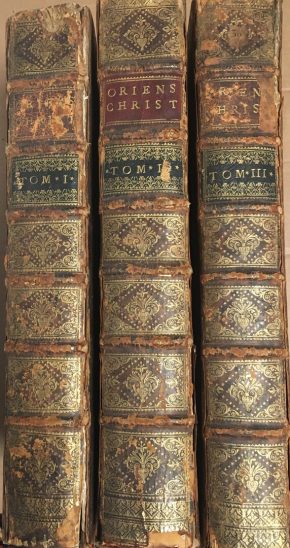Oriens Christianus, in quatuor patriarchatus digestus; quo exhibentur Ecclesiae, Patriarchae, caeterique praesules totius orientis. THREE VOLUMES.
Le Quien, Michel (1661-1733).
Synopsis
Oriens christianus in quatuor patriarchatus digestus, in quo exhibentur Ecclesiae patriarchae caeterique praesules totius Orientis, was published posthumously (3 vols., Paris, 1740). Le Quien contemplated issuing this work as early as 1722, and had made a contract with the printer Simart (Revue de l’Orient latin, 1894, II, 190). In editing it, he used the notes of the Benedictine Sainte-Marthes, who had projected an “Orbis Christianus”, and had obligingly handed him over their notes on the Orient and Africa. The “Oriens Christianus”, as projected by Le Quien, was to comprise not only the hierarchy of the four Greek and Latin patriarchates of Constantinople, Alexandria, Antioch, and Jerusalem, and that of the Jacobite, Melkite, Nestorian, Maronite, and Armenian patriarchates, but also the Greek and Latin texts of the various Notitiae episcopatuum, a catalogue of the Eastern and African monasteries, and also the hierarchy of the African Church. The last three parts of this gigantic project were set aside by Le Quien’s literary heirs. His notes on Christian Africa and its monasteries have never been used, at least not in their entirety.
Various attempts have been made over the years to bring a sense of order to the complex and sometimes chaotic histories of the eastern churches. One aspect of this effort has been to publish lists of bishops of individual dioceses to show the historical continuity of the church in a particular place. The French Dominican theologian and historian Michel Le Quien (1661–1733) was the first to do this in a systematic way in his Oriens christianus in quatuor patriarchatus digestus, in quo exhibentur Ecclesiae patriarchae caeterique praesules totius Orientis, published posthumously in three volumes in Paris in 1740. Taking an exclusively topographical approach, Le Quien produced exhaustive lists with biographical notes of bishops of dioceses within the territory of the four ancient eastern Patriarchates (Constantinople, Alexandria, Antioch, and Jerusalem) as well as dioceses in outlying areas reaching out into Africa and into Asia as far as India. Le Quien’s opus remained the standard work in the field for centuries. But as it grew more and more outdated, there were increasing calls for a new Oriens Christianus; the eastern Church specialist Adrian Fortescue called for such an effort in 1907.
Michel Le Quien (1661- 1733) was a French historian and theologian. He studied at Collège du Plessis, Paris, and at twenty entered the Benedictine Abbey of Saint-Germain-des-Prés, where he made his profession in 1682. Except for occasional short absences, he never left Paris. At the time of his death he was librarian of the convent in Rue Saint-Honoré, a position which he had held almost all his life, lending assistance to those who sought information on theology and ecclesiastical antiquity. Under the supervision of Père Marsollier he mastered the classical languages, Arabic, and Hebrew, to the detriment, it seems, of his mother-tongue.
Bibliographic reference: Brunet I, 997. – Geschichte des östlichen Christentums, laut Brunet und Graesse ein Supplement zu “Byzantinae Historiae Scriptores”.






